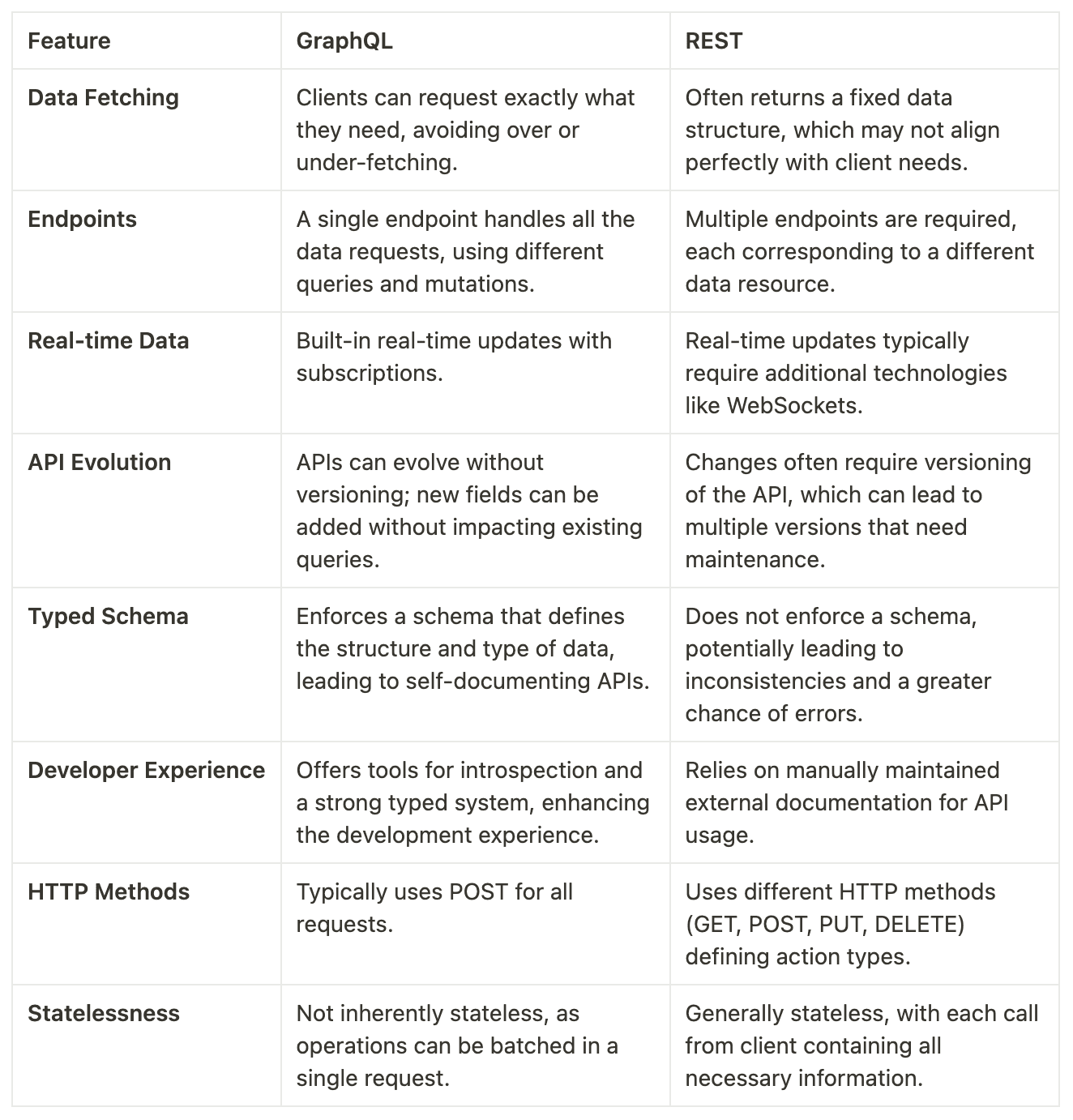GraphQL vs REST

Luke Stephens
Nov 3, 2023
GraphQL vs REST
GraphQL allows clients to request only the data they need, making it efficient for complex systems with interconnected data. REST, on the other hand, is based on standardized HTTP methods and is simpler to implement for basic CRUD operations. Choose GraphQL for highly interactive applications requiring real-time data or when the data structure is complex. REST is ideal for simpler, less data-dependent applications or when leveraging existing HTTP infrastructure.
Selecting the right API architecture is a decision that can significantly impact the functionality and scalability of your application. This table compares GraphQL and REST across key features such as data retrieval, endpoint management, and real-time communication:
Here are the main differences between GraphQL and REST:
Data Fetching: In GraphQL, clients can request exactly what they need, avoiding over or under-fetching. On the other hand, REST often returns a fixed data structure, which may not align perfectly with the client's needs.
Endpoints: GraphQL has a single endpoint that handles all the data requests, using different queries and mutations. REST requires multiple endpoints, each corresponding to a different data resource.
Real-time Data: GraphQL has built-in real-time updates with subscriptions. Real-time updates in REST typically require additional technologies like WebSockets.
API Evolution: APIs in GraphQL can evolve without versioning; new fields can be added without impacting existing queries. In contrast, changes in REST often require versioning of the API, which can lead to multiple versions that need maintenance.
Typed Schema: GraphQL enforces a schema that defines the structure and type of data, leading to self-documenting APIs. REST does not enforce a schema, potentially leading to inconsistencies and a greater chance of errors.
Developer Experience: GraphQL offers tools for introspection and a strong typed system, enhancing the development experience. REST relies on manually maintained external documentation for API usage.
HTTP Methods: GraphQL typically uses POST for all requests. REST uses different HTTP methods (GET, POST, PUT, DELETE) defining action types.
Statelessness: GraphQL is not inherently stateless, as operations can be batched in a single request. REST is generally stateless, with each call from the client containing all necessary information.
Below is the difference in tabular format

While REST may be simpler and better for less complex data interactions, GraphQL offers detailed and efficient data handling ideal for complex applications needing flexible data access.
Let's look at an example of fetching data with both GraphQL and REST:
Example of GraphQL vs REST
GraphQL
In this example, you can see that GraphQL allows you to fetch specific fields (name, email, friends) for a particular user. It even allows you to fetch nested data, like the names of the user's friends.
REST
This REST API call fetches the data for a user with the ID of 1. However, unlike the GraphQL example, it fetches all the data associated with that user, not just the name, email, and friends. To get the user's friends' names, another API call such as GET /users/1/friends might be needed, leading to multiple requests and over-fetching of data.
Choosing Between GraphQL and REST
Use GraphQL when:
You require efficient data loading, particularly in mobile applications or on networks with limited bandwidth.
The client application needs the flexibility to request varying sets of data.
You want to minimize the number of requests and the amount of data transferred.
Real-time data (like updates in a social network feed) is a core requirement.
Use REST when:
The simplicity and statelessness of REST align with your project’s needs.
Your team has existing expertise in RESTful services.
You need to leverage robust HTTP caching mechanisms to improve performance.
The API serves relatively standard or predictable data requirements.
Learn more about GraphQL -
Explore more from Akto
Blog
Be updated about everything related to API Security, new API vulnerabilities, industry news and product updates.
Events
Browse and register for upcoming sessions or catch up on what you missed with exclusive recordings
CVE Database
Find out everything about latest API CVE in popular products
Test Library
Discover and find tests from Akto's 100+ API Security test library. Choose your template or add a new template to start your API Security testing.
Documentation
Check out Akto's product documentation for all information related to features and how to use them.

